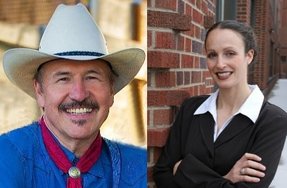
One of the most recent articles I’ve seen on the issue is What to expect in Montana’s special election, put up on January 6 by NBC Montana.
Lee Banville mentions that “voter turnout is expected to be lower than ever before, making the results of the election highly unpredictable.”
He also suggests that all the candidates will be “largely unknown” at the statewide level.
I thought about profiling both Casey Schreiner of Great Falls and Kelly McCarthy of Billings in this post.
I decided not to, for two reasons:
- First, I already wrote several pages on Quist vs. Curtis before coming back to do this introduction.
- Second, in writing those pages I convinced myself that neither Schreiner nor McCarthy have a chance against those two.
I could be wrong about that.
I could be wrong about all that follows.
I don’t think I am, however.
Quist’s biggest hurdle, in my opinion, is going to be MEA-MFT.
Eric Feaver’s already commanded his organization to begin Facebook advertising for Curtis.
That’s one of the things I don’t like about Curtis, or any teacher/retired teacher that’s running for office – the hooks that Feaver and his organization have in those candidates.
Now, MEA-MFT isn’t a bad organization.
For the most part they’re good teachers that are just doing their job.
It’s the top of the organization that I worry about: all the people that play the political games, make a lot of money doing it, and when it’s all said and done our teachers are still making the lowest starting wage in the nation.
That’s why I’m sometimes called anti-union – because I feel unions should be benefiting those doing the most work before those at the top.
Anyways, going against an MEA-MFT-sponsored candidate is tough.
I’ve done it twice. The first time I even went to the MEA-MFT interview.
Yeah, I was still pretty naïve in early-2014…going to a meeting when my opponent was a retired teacher, and thus a dues-paying MEA-MFT member for years.
In 2016 I didn’t even bother, considering my opponent that year was an MEA-MFT fundraiser at one point.
The point is, when you’re going against a union-backed candidate it closes a lot of doors for you, both with voters and with fundraisers.
Money will become critically important after the nominating convention, though it’ll play an important role before as well.
If you can go into that convention with tens of thousands of dollars in donations already built up, it’ll be hard for delegates to ignore that.
Curtis has a fundraising network built up from 2014.
Quist will have to rely on what Brian Schweitzer can help him with and what other, high-ranking, “elite-level” Democrats around the state can help him with.
But…do they want to help him?
One of the most pertinent comments I've heard was by UM political science professor Rob Saldin on Friday’s Capitol Talk.
“...in his statement, Schweitzer emphasized Quist's role as an outsider. The problem with that is that it's going to be the party insiders who'll be picking the nominee...
This is going to be something like the modern-day equivalent of the old smoke-filled rooms...
So running as an outsider when it's the insiders who are in charge, I think probably will be something of a liability.
And beyond that, I'm not sure that Quist has any significant history of engagement with the Democratic Party, so it'd kinda be surprising if the state's elite-level Democrats tap an outsider like Quist unless they're really underwhelmed by the other candidates and decide that their best chance is some kind of desperation, shoot the moon strategy.”
Ouch.
“Shoot the moon strategy.”
That doesn’t sound too good. Doesn’t sound like Saldin has a lot of faith in Quist.
Maybe he’s right.
And maybe Quist needs to do some sort of desperate, ‘shoot the moon strategy’ type of campaign.
How else is he supposed to convince those “elite-level” Democrats?
And do they want to be convinced?
Yes, it all gets back to the delegates.
Boy – it’s tough reading their minds. I don’t even know who they are!
While I’d tempted to identify all NUMBER of them and send them cards and flowers and whatever, I’m not sure that strategy will work.
To convince the delegates you have to sway the media to you, which can then sway public opinion to you.
This can prove beneficial if any of the state newspapers do a poll the week or so before the convention.
Let’s say it’s Quist coming in at 40% and Curtis around 35%.
Many delegates could begin having second thoughts about Curtis, the delegates that MEA-MFT or some other organization/fundraiser could have leaned on them to support.
Now let’s say Curtis is coming in at 40% support and Quist is right behind her with 35%.
Delegates may play it safe and go with a known-factor, which is Curtis.
It’s all really hard to say, and I don’t want to step on any toes…though in the hypothetical newspaper poll I only see Schreiner/McCarthy getting around 10% each.
Mostly it’s an uphill battle for Quist, who’s the only one who has a shot at beating out Curtis, and that mainly because Schweitzer supported him.
Hell, the guy’s only got about a month until the nominating convention takes place!
Is there any point in even thinking about the ‘general election’ yet, which the fundraising is supposed to be for?
Let’s not forget that it’s only going to be a 3 to 4 month campaign for the general in the first place, probably timed to coincide with the school elections in May to save the counties some costs.
- The real challenge for all these Dems is convincing the delegates that they can either beat out the GOP candidate or build-up significant name recognition for a serious bid at a statewide office in 2020, if not another run at the House in 2018.
- Another key determining factor in any candidate will be whether they intend to stay in the House for a certain period, or use it as a stepping stone to go after Daines in 2020 or perhaps jump down (up?) to governor that same year.
I feel Quist has the edge here.
He’s 69-years-old.
He’s ending a career more than he’s starting one.
He could be a damn good person to carry Montana Dems into the mid-2020s with the state’s sole U.S. House seat under their belt.
You’ll remember my analysis of Dems chances for the U.S. House all the way up to 2022 when we’ll probably get back to two seats.
I can see someone like Quist stepping down in 2022 or 2024 after several years of service, and a good Democratic bench candidate ready to fill his shoes.
With Curtis that’s not going to happen.
Now, it’s true that she could stay in the House for the next 20 years or longer.
I just have a feeling that she’d jump to a senate or governor’s race long before that, and one she might not win.
Boom – the seat is back under GOP control, and we know that control can last two decades or longer.
That’s assuming Curtis even wins this nominating convention and then wins against whoever the GOP opponent is.
Then she’d have to keep her seat in 2018, when voter turnout will be higher, perhaps favoring Republicans…if that’s not already the case this year, an off-off-year when Dem turnout will be even lower than usual.
Nope, it’s not looking good.
Quist is sure working hard, however. In fact, I haven’t seen someone work this hard this fast since Gianforte was going around in December 2015.
I expect we’ll see Quist going around soon as well. I expect this will help him a great deal.
Let me just say, I like Amanda Curtis.
I’m sure I’ll like Rob Quist when I eventually meet him.
I’m sure both of them will support the other if they happen to lose out in this race.
Until then, it’ll get rough.
It’s not a regular campaign, one where you convince voters.
- It’s a campaign to convince top-level Democrats around the state, many of whom could have wildly separate agendas from both you and I and their own fellow delegates.
- It’ll be a media campaign, one relying on the TV stations and newspapers, perhaps the blogs to a lesser extent.
- Social media advertising will be a very large factor, with Facebook taking up hundreds if not thousands of dollars even before the convention.
Why?
In the hope that it’ll convince regular Montanans to somehow voice their support for that particular candidate.
Then maybe, just maybe, that support will get back to one of these delegates…none of whom we really know in the first place.
Well, that might not be quite true. Back in 2014 it was the central committee of the Montana Democratic Party that selected Curtis as Walsh’s replacement.
So who is the central committee today?
That’s hard to say – when Dems redesigned their website they took that information down.
I’m sure some important people know, but I’m not one of ‘em.
In fact, for years now I’ve tried to discern the inner workings and machinations of the Montana Democratic Party, who the players are, how they got there, and what their agendas are…all to no avail.
Maybe Lynn Stanley and Dave Fern would be two for Quist to talk to, considering they head up the Flathead County central committee of the Montana Democratic Party.
I’m sure he’s done that, although I don’t know if they support him or not.
Perhaps an appearance at the Flathead Democrats’ Martin Luther King Day Dinner would help.
Hey, it ain’t easy.
Suddenly you have to go out and figure out who all the important people are.
And now candidates have to convince these important people that they’re the right one for the job.
Damn, how do you run a campaign like that?
I really don’t know.
But in about a month I will…we all will.
Trump’s inauguration is less than two weeks away and the nominating convention will be a short time after that.
Boy, this is gonna be exciting!

